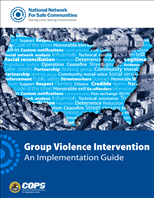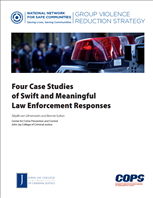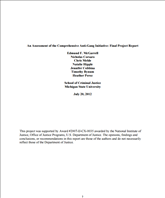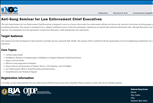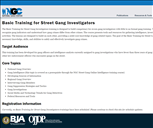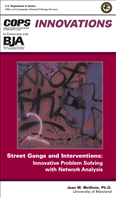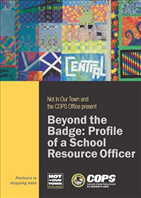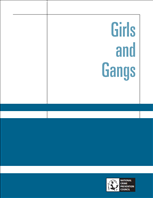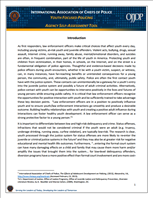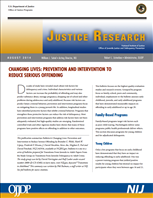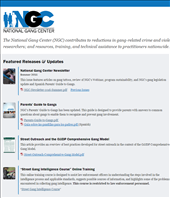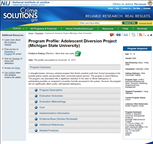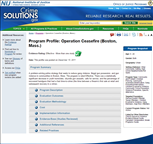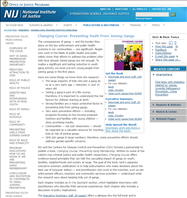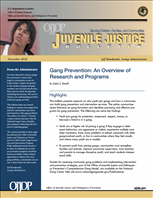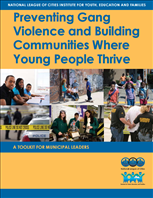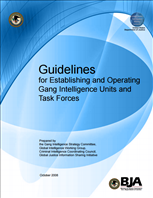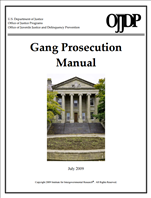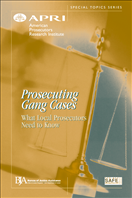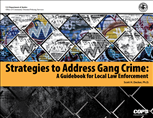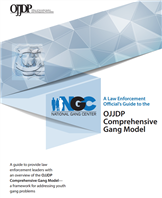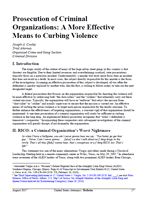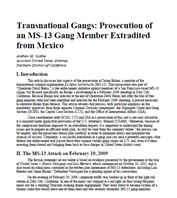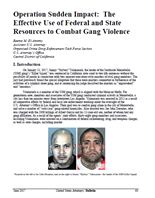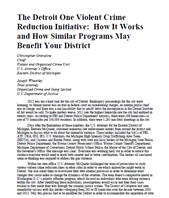Toolkit: Gang Investigation, Prosecution, and Intervention Resources
Custom Notifications: Individualized Communication in the Group Violence Intervention
The National Network for Safe Communities' Group Violence Intervention (GVI) has repeatedly demonstrated that serious violence can be reduced when law enforcement, community members, and social service providers join together to engage directly with violent street groups and clearly communicate (1) a credible, moral message against violence; (2) a credible law enforcement message about the group consequences of further violence; and (3) a genuine offer of help for those who want it. Custom Notifications: Individualized Communication in the Group Violence Intervention provides practical information about "custom notifications," an independent element of GVI that enables quick, tactical, direct communication to particular group members.
Group Violence Intervention: An Implementation Guide
The National Network for Safe Communities' Group Violence Intervention (GVI) has repeatedly demonstrated that serious violence can be reduced when law enforcement, community members, and social service providers join together to engage directly with violent street groups and clearly communicate (1) a credible, moral message against violence; (2) a credible law enforcement message about the group consequences of further violence; and (3) a genuine offer of help for those who want it. This publication provides comprehensive guidance on how to implement GVI step by step, discussing the role and responsibilities of the core representatives in law enforcement, the community, and social services. It explains the logic and basics of the strategy before taking the reader through the initial planning stages, design, and execution of all key strategy elements, such as problem analysis and the call-in.
Group Violence Reduction Strategy: 4 Case Studies of Swift and Meaningful Law Enforcement Responses
The publication captures examples of successful and creative law enforcement responses to group violence as carried out by police departments at key National Network jurisdictions. The National Network for Safe Communities' Group Violence Reduction Strategy (GVRS), also known as "Operation Ceasefire," has repeatedly demonstrated that serious violence can be dramatically reduced when law enforcement, community members, and social services providers join together to directly engage with violent street groups to clearly communicate (1) a law enforcement message that future violence will be met with clear and predictable consequences, (2) a community moral message that violence will no longer be tolerated, and (3) a genuine offer of help to those who want it. The strategy's central tool to communicate these messages is a call-in a face-to-face meeting between GVRS representatives and street group members.
A Parent's Quick Reference Card Recognizing and Preventing Gang Involvement
This quick reference guide provides common warning signs of gang involvement, but may not be all-encompassing. Parents should look for multiple signs to indicate possible gang involvement because some of these indicators alone, such as clothes or musical preferences, are also common among youth not involved in gangs. Parents are encouraged to familiarize themselves with local gang symbols, seek help early, and consider contacting school personnel, local law enforcement, faith leaders, and community organizations for additional assistance.
Addressing Gangs in Our Schools
This bulletin addresses several prevention strategies that schools can use to prevent gangs in their campuses. A few best practices from the field are also presented.
An Assessment of the Comprehensive Anti Gang Initiative
Concerned with levels of gang-related violent crime and responding to field reports from officials involved in Project Safe Neighborhoods (PSN), the U.S. Department of Justice developed the Comprehensive Anti-Gang Initiative (CAGI) to support local communities in their efforts to prevent and control gang crime. Initial CAGI awards were made to six communities in 2006, four more in 2007, and two in 2008.
Compilation of Gang-Related Legislation
Legislation listed on this site refers to laws that are in effect. No proposals pending in state or federal legislatures are included until they have become enforceable laws in effect. On a rare basis, laws in effect are declared unconstitutional in whole or in part after judicial review. Double-check the current status of any law listed on this site before assuming it is valid or acting in reliance upon it. This information is updated as new legislation and existing legislation are identified.
Gang Resistance Education And Training (G.R.E.A.T.) Officer In-Service Training
G.R.E.A.T. Officer In-Service Training (GOI) is an advanced 24-hour training for G.R.E.A.T. instructors who have taught G.R.E.A.T. for at least one year. The goal of the training is to provide an interactive and self-directed forum where instructors will learn: 1) How to more effectively implement, facilitate, and sustain the G.R.E.A.T. Program 2) New ways to ethically respond to common situations involving school staff, parents, and students using effective communication, interaction, and coping skills.
Helping At-Risk Youth Say "No" to Gangs
An NIJ-funded evaluation finds that a revised curriculum and greater attention to teacher training have resulted in an improved program for preventing gang membership and delinquency.
National Gang Center
The National Gang Center (NGC) is a project jointly funded by the Office of Juvenile Justice and Delinquency Prevention (OJJDP) and the Bureau of Justice Assistance (BJA), Office of Justice Programs (OJP), U.S. Department of Justice (DOJ). The NGC is an integral component of the Justice Department’s mission to provide innovative leadership in coordination with federal, state, local, and tribal justice systems to prevent and reduce crime. The NGC disseminates information, knowledge, and outcome‐driven practices that engage and empower those in local communities with chronic and emerging gang problems to create comprehensive solutions to prevent gang violence, reduce gang involvement, and suppress gang‐related crime.
Street Gang Investigator Training - National Gang Center (NGC)
This three-day class offers not only basic, entry-level training, but more advanced gang training for law enforcement agencies and features research- and field-based information tailored for regional applicability. These trainings provide instruction on how to recognize and identify gang members and their insignia; ways to develop sources of information about gang activities within the community and through social media investigative techniques; how to manage confidential gang informants and witnesses; management and policy issues; strategies for suppressing gang activity; and multijurisdictional approaches to gang investigations. These curricula have been developed, tested, and presented throughout the United States. Training modules are taught by experts in the field, all with ten or more years of real-world experience.
Anti-Gang Seminar for Law Enforcement Chief Executives - National Gang Center (NGC)
The Anti-Gang Seminar for Law Enforcement Chief Executives is designed to serve as a forum where senior law enforcement officials can discuss real, executive-level issues involving gangs and share innovative and promising approaches. The seminar is designed to be a collegial, facilitated event in which the participants' experiences are shared and constitute educational value. Through discussions and brief scenario-based exercises, the participants have the opportunity to learn from their peers, while sharing their own experiences.
Basic Training for Street Gang Investigators - National Gang Center (NGC)
The Basic Training for Street Gang Investigators training is designed to build competency for sworn gang investigators with little to no formal gang training. The training provides officers with information to better recognize gang indicators and understand how gang crimes differ from other crimes. The course presents tools and resources for gathering intelligence, investigating gang crimes, and performing gang suppression activities. The lessons are designed to build on each other, providing a solid-core knowledge of gang-related topics. The goal of the Basic Training for Street Gang Investigators course is to provide officers with the necessary knowledge, skills, and abilities to safely and effectively investigate gang crimes. This training has been developed for gang officers and intelligence analysts currently assigned to gang investigations who have fewer than three years of gang investigation experience. This training will also benefit other law enforcement officers who encounter gangs on the street.
OJJDP Comprehensive Gang Model
The OJJDP Comprehensive Gang Model is a set of five core strategies—community mobilization, opportunities provision, social intervention, suppression, and organizational change and development—that offer a comprehensive, collaborative approach designed to prevent and reduce gang violence.
Gang Unit Supervision Training - National Gang Center (NGC)
This two-day class is intended for officers who are currently or soon to be assigned as supervisors in gang units. Although this curriculum is designed for personnel who operate against street gangs, security threat group supervisors are accepted on a space-available basis.
Street Gangs and Interventions: Innovative Problem Solving with Network Analysis
This publication briefly reviews the range of prevention, intervention, suppression, and comprehensive strategies, providing examples of each type. It then offers a case study of problem analysis in Newark, New Jersey. The Greater Newark Safer Cities Initiative (GNSCI) began in 1996 as a collaborative effort among law enforcement, community groups, social service agencies, clergy, and Rutgers University to address and temper the local violence problem. By 2003, the partners in GNSCI expressed concern over a perceived growth in street gangs and related crime. Accordingly, the North Jersey Gang Task Force emerged under the framework and from the existing partnerships of GNSCI. This publication also discusses the unique utility of network analysis in the resultant problem analysis and underscores the important role of an academic research partner. Finally, the paper considers the importance of sustainability with regard to problem analysis.
Beyond the Badge: Profile of a School Resource Officer DVD
In the midst of turmoil and division between law enforcement and the community of Ferguson, Missouri, St. Louis County School Resource Officer Ronald Cockrell works to bridge the gap between students and police officers. Beyond the Badge: Profile of a School Resource Officer follows Officer Cockrell during a school day at Central Middle School in Riverview Gardens, six months after the police shooting and protests that left North St. Louis County reeling. The story focuses on Cockrell's efforts to build relationships, listen to students address fear of the police in a school town hall, mentor young people on how to deal with conflicts, and work with his colleagues to respond and support a student whose father is murdered. This short film is designed to prompt conversations in law enforcement agencies, schools, and communities about the role SROs can play in improving relationships between students and law enforcement and mentoring and supporting young people as they navigate conflicts and interactions with the justice system. This film is part of the Working Together for Safe, Inclusive Communities Initiative, a collaboration between Not In Our Town and the U.S. Department of Justice's Office of Community Oriented Policing Services. This free resource is available for law enforcement agencies to use in their communities.
Girls and Gangs
This document explores the prevalence of girls and gangs, why girls join gangs, the activities that girl gangs participate in, and strategies for keeping girls out of gangs.
Parents’ Guide to Gangs
Parents play an important role in keeping young people out of gangs. There are many things parents can do to help their children stay away from gangs, including monitoring their activities, fostering close relationships with them, and using positive and consistent discipline. However, parents often lack factual information about gangs. This guide is designed to provide parents with answers to common questions about gangs to enable them to recognize and prevent gang involvement.
Youth Focused Policing Agency Self-Assessment Tool
What are your agency strengths in responding to youth crime, delinquency, and victimization? What areas need improvement? Could your agency benefit from implementing a Youth Focused Policing strategy? Assess your agency's current state of policy and practice in prevention and response strategies to reduce juvenile offending, reoffending and victimization with the Youth Focused Policing Agency Self-Assessment. This new IACP resource, supported by the Office of Juvenile Justice and Delinquency Prevention, Office of Justice Programs, U.S. Department of Justice, aims to assist law enforcement agencies in early identification of trends, resources, and community partnerships that may be helpful in identifying best practice responses to improving the safety and well-being of youth in their communities.
Changing Lives: Prevention and Intervention to Reduce Serious Offending
This bulletin focuses on the highest quality evaluation studies and research reviews. Grouped by program focus — family, school, peers and community, individual, employment — the bulletin assesses early childhood, juvenile, and early adulthood programs that have demonstrated measurable impacts on offending in early adulthood or up to age 29.
Street Gang Intelligence Course Online Training
This online training course is designed to assist law enforcement officers in understanding the steps involved in the intelligence process and applicable standards, suggests possible sources of information, and highlights some of the problems encountered in collecting gang intelligence. This course is restricted to law enforcement personnel.
Why Youth Join Gangs
This video presentation features gang researchers, practitioners, and young people who were previously involved in gangs. Learn about research regarding gang joining, as well as firsthand insights into the behaviors and the circumstances that you might observe when interacting with youth who are at high risk of joining a gang.
Street Outreach and Law Enforcement Collaboration: Prioritizing Safety When Working With Gang Members
This Webinar outlines how best to conduct street outreach when gang-involved clients are in danger. The Webinar features the collaborative relationship between the Houston Mayor's Anti-Gang Office and the Houston Police Department as a best-practice program to address street gang violence.
Adolescent Diversion Project (Michigan State University)
Crimesolutions.gov: A strengths-based, advocacy oriented program that diverts arrested youth from formal processing in the juvenile justice system and provides them community-based services. This program is rated Effective. The program was associated with a significant reduction in the rates of official delinquency of participating juveniles as compared to juveniles formally processed in the system. However, the program did not significantly affect youths’ self-reported delinquency.
Operation Ceasefire (Boston, Massachusetts)
Crimesolutions.gov: A problem-solving police strategy that seeks to reduce gang violence, illegal gun possession, and gun violence in communities in Boston, Mass. The program is rated Effective. There was a statistically significant decrease in youth homicides, citywide gun assaults, calls for service, and the percentage of recovered handguns that had a fast time-to-crime (the time between a firearm’s first sale at retail and subsequent recovery in a crime).
Gang Reduction Program (Los Angeles, California)
Crimesolutions.gov: A comprehensive, multiyear initiative to reduce youth gang crime and violence through a combination of strategies. This program is rated Promising. It was associated with a significant decrease in the number of calls reporting shots fired and gang-related incidents in the target area. However, it did not have a significant effect on the number of calls reporting vandalism or gang or non-gang related serious violence incidents or on attendance levels of elementary, middle, or high schools.
Gang Resistance Education (G.R.E.A.T.) Web site
Gang Resistance Education And Training (G.R.E.A.T.) is an evidence-based and effective gang and violence prevention program built around school-based, law enforcement officer-instructed classroom curricula. The Program is intended as an immunization against delinquency, youth violence, and gang membership for children in the years immediately before the prime ages for introduction into gangs and delinquent behavior.
Gang Resistance Education And Training (G.R.E.A.T.) FAQ
This Website features frequently asked questions regarding the G.R.E.A.T. program for the public, educators, law enforcement, parents/guardians, and students.
Frequently Asked Questions About Gangs
Answering many questions regarding gangs, gang joining, gang trends, and more, this document provides a list of the most commonly asked questions received by the NGC.
Preventing Youth Violence: Opportunities for Action
To help communities take advantage of the available knowledge, CDC has developed, Preventing Youth Violence: Opportunities for Action. This resource summarizes what we currently know about youth violence—the health consequences, trends, disparities, causes, costs, and prevention strategies. This resource outlines important strategies for youth violence prevention that are based on strong evidence and experience. It includes examples of specific programs and activities that have been found to be effective. These evidence-based youth violence prevention strategies focus on reducing the factors that put young people at risk for violence and bolstering the factors that strengthen their positive development and buffer against violence.
Changing Course: Preventing Youth From Joining Gangs
Changing Course offers evidence-based principles that can halt the cascading impact of gangs on youth, families, neighborhoods and society at large. The goal of the book (and a separate executive summary publication) is to help policymakers who make decisions about the best use of taxpayer dollars — and practitioners who work in the trenches, such as law enforcement officers, teachers and community services providers — understand what the research says about keeping kids out of gangs.
Gang Prevention: An Overview of Research and Programs
This bulletin presents research on why youth join gangs and how a community can build gang prevention and intervention services. The author summarizes recent literature on gang formation and identifies promising and effective programs for gang prevention.
Preventing Gang Violence and Building Communities Where Young People Thrive: A Toolkit for Municipal Leaders
As a resource for mayors, councilmembers, senior municipal staff, law enforcement officials and community stakeholders and service providers, this toolkit shows how communities participating in the California Cities Gang Prevention Network — as well as cities throughout the nation — infuse their anti-gang work with six core principles. Recognizing that these efforts require resources, the toolkit begins by exploring the wide range of funding strategies and sources that cities have used to support their gang reduction efforts, and the implication that federal and state funding streams must be made more flexible in supporting the implementation of comprehensive local gang prevention plans.
Gang-Related News Articles
This page provides a list of articles pertaining to gangs and gang-related activities from various U.S. and Canadian news sources. A link to the source of each article is provided. The list of articles can be refined and filtered by date and limited to a specific state or Canadian province or territory.
Guidelines for Establishing and Operating Gang Intelligence Units and Task Forces
This document provides guidance to agencies seeking to establish and operate a gang task force or gang intelligence unit within their jurisdiction or those agencies that participate in a gang task force.
Gang Prosecution Manual
This is a workbook designed to help local prosecutors and investigators visualize and prepare for every step of a gang‐related crime prosecution, from the initial crime scene investigation to preparing and presenting the case and, finally, sentencing issues specific to gang cases. This document has been prepared by working prosecutors and investigators from states with very different legal requirements. They have years of experience in dealing with the complexities of violent gang‐related crime. The intent of this manual is to assist local prosecutors in holding gang‐involved offenders accountable for their actions and, ultimately, guarding the community from gangs.
Prosecuting Gang Cases: What Local Prosecutors Need to Know
This monograph seeks to address various pre-trial and trial issues in the context of gang evidence. Hypothetical examples are used for illustrative purposes.Additionally, this presentation includes references to California’s Street Terrorism Enforcement and Protection (STEP) Act, which has spearheaded the country’s state legislatures’ answer to the growing national epidemic known as gang crime.
Gangs Toolkit - COPS Office
Street gang crime can take many forms. The COPS Gangs Toolkit consists of resources for law enforcement officials, educators, and parents to address specific types of crimes committed by gangs.
Strategies to Address Gang Crime: A Guidebook for Local Law Enforcement
This document provides information about developing and enhancing local law enforcement responses to gangs in their jurisdictions. The focus of the guidebook is on the use of problem-solving strategies to help agencies select the interventions most appropriate for their jurisdictions. In particular, the guidebook describes the SARA model (Scanning, Analysis, Response and Assessment), a strategic problem-solving process that local law enforcement can apply to its local gang problem. Growing evidence (Dalton, 2004) shows that applying the SARA model will greatly improve the law enforcement response to gangs and will lead to safer communities.
A Law Enforcement Official’s Guide to the OJJDP Comprehensive Gang Model
The OJJDP Comprehensive Gang Model provides a framework for coordinated community action to prevent youth from joining gangs and reduce street gang crime and violence. This brochure identifies law enforcement’s role in the process.
Prosecution of Criminal Organizations - A More Effective Means to Curbing Violence
A federal prosecution that focuses on the organization responsible for directing the violence will be more effective by addressing both “the shot-callers” and the “soldiers” that ultimately carry out these violent missions. Typically, the organization will have an “enforcer” that relays the mission from “shot-caller” to “soldier” and usually supervises to ensure that the mission is carried out. An effective means of curbing the urban violence is to target each person responsible for the deadly outcome. To further enhance the effectiveness of targeting organizations, a constant vigil of that organization should be maintained. A one-time prosecution of a criminal organization will rarely be sufficient in curbing violence in the long term. An experienced federal prosecutor recognizes that “today’s defendant is tomorrow’s cooperator.” Incorporating these cooperators into subsequent investigations of the criminal organization will greatly disrupt, if not dismantle, the organization.
Transnational Gangs: Prosecution of an MS-13 Gang Member Extradited from Mexico
This article discusses key aspects of the prosecution of Jaime Balam, a member of the transnational criminal organization La Mara Salvatrucha (MS-13). That prosecution was part of “Operation Devil Horns,” a law enforcement initiative against members of a San Francisco-based MS-13 clique, but focused specifically on Balam’s involvement in a February 2009 shooting in Daly City, California. Because Balam was indicted at the end of Operation Devil Horns and after the trial of two gang members who had been identified and indicted for the February 2009 shooting, it proved necessary to extradite Balam from Mexico. This article reviews that process, with particular emphasis on the mandatory approvals from three separate Criminal Division components: the Organized Crime and Gang Section (OCGS), the Capital Case Section (CCS), and the Office of International Affairs (OIA).
Gang Experts: Best Practices and Avoiding Pitfalls
Since the 1980s, gang experts have become an increasingly commonplace sight in federal courtrooms. A gang expert’s testimony has advantages and disadvantages: on the one hand, the expert can provide a comprehensive overview of the gang and introduce jurors to a criminal world they would not otherwise understand.87 A poised, effective expert at the beginning of your case can set the stage for the rest of your evidence, some of which may come from less-than-articulate cooperators. And in the RICO context, an expert alone may be able to establish the existence of the enterprise.88 On the other hand, an expert is almost sure to draw legal challenges at the trial level, as well as scrutiny and potentially reversal on appeal.89 The question that frequently arises in cooperator-driven cases is: why use a gang expert if you have cooperators who can testify about much of the same information?
Operation Sudden Impact: The Effective Use of Federal and State Resources to Combat Gang Violence
Between 2011 and 2013, federal and local law enforcement worked together to use their collective experience and resources to engage in a variety of investigative techniques to target, and ultimately dismantle, a violent criminal organization. Operation Sudden Impact ultimately resulted in solving six “cold case” gang-related murders, and obtaining convictions against dozens of individuals affiliated with a violent criminal street gang. The collaborative and strategic efforts made by federal and local law enforcement working together to bring cases against SSM gang members and associates, left the city of Montebello, even years later, a safer place to live.
The Detroit One Violent Crime Reduction Initiative: How It Works and How Similar Programs May Benefit Your District
The Initiative had three components: (1) identify and prosecute priority offenders; (2) dismantle violent gangs and criminal organizations; and (3) engage the community to act. As for the first component, priority offenders, known colloquially as “trigger pullers,” were individuals who had committed, were committing, or were most likely to commit a crime while using or shooting a firearm. By working together and utilizing their combined intelligence to identify the most significant “trigger pullers,” law enforcement agencies could efficiently allocate their time and resources to investigate some of the most dangerous individuals in the city.
National Gang Intelligence Center
The National Gang Intelligence Center (NGIC) is a multi-agency fusion center responsible for the gathering and sharing of timely information to federal, state, local, and tribal law enforcement and correctional agencies regarding the growth, migration, criminal networks, patterns, trends, and associations of gangs whose violent criminal activities pose a significant threat to communities throughout the nation. The NGIC is comprised of intelligence professionals from the Federal Bureau of Alcohol, Tobacco, Firearms, and Explosives (ATF); the Federal Bureau of Prisons (BOP); the Drug Enforcement Administration (DEA); the Federal Bureau of Investigation (FBI); the U.S. Marshals Service (USMS); and the Department of Defense (DoD). These agencies integrate their resources in order to provide the most accurate, all-inclusive view of the gang situation in the United States.
Project Safe Neighborhoods Strategic Action Plan Template
This document, developed by the Michigan State University, provides a template for developing a strategic action plan for implementing the Project Safe Neighborhoods initiative. This includes questions and examples related to the planning phase and implementation plan, and also includes worksheets, logic models, and more.

